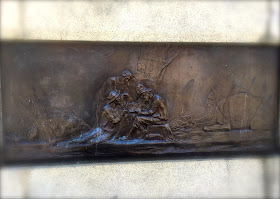The Burke and Wills story, a supposedly heroic tale encapsulates all the perfect ingredients of a potentially successful blockbuster: A noble mission to unfold riddles of inner continent, starving explorers confronting unknown wilderness at the far north of Melbourne, tough endurance of formidable desert, a journey beset with scarcity of foods and treacherous weather. The legend ended with tragic deaths of the protagonists and a posthumously erected Michelangelo-style sculpture. With a little sprinkle of skilled cinematography and euphonic sound mixing, the story might have easily turned into the next Oscar-winning Revenant.
Yet how we wish the
over-glorification could be justified without a pang a doubt. For despite the
glorious height of the public monument and the overwhelming public sentiment in
the 1860s, the Burke and Wills expedition is a testament of foolhardiness and
incompetence, an ignominious defeat tainted with too many blunders and human
follies.
Led by the inexperienced
Burke, the grand expedition was almost doomed to fail from the outset. Just few
weeks after setting off from the Marvelous Melbourne, an ill-conceived plan and
ineptitude leadership caused successive resignations and departures of
expedition members. Series of error of judgment saw the disposal of various
stores and supplies, a foolish action proved to be fatal in hindsight. News of
a rival continental-crossing plan from home triggered Burke’s insecurity and
anxiety, the last straw that eventuated the rash decision of the strong-headed
leader to split the team and race more than 1000 km towards Gulf Carpentaria in
the fiercest December heat of 50° C. They walked a remarkable
3500 km from Melbourne, almost reached their intended destination, prevented
only by the mangrove swamps.
Camels and the only horse
were slaughtered and eaten on the return journey. Attacks of Monsoonal rain and
dysentery ended the life of Gray and brought the exhausted Burke, Wills and
King to the brink of weariness. Upon arriving the Cooper Creek depot, the emaciated
Burke team was greeted by a deserted camp and an instruction to dig carved into a tree trunk. Inadequate supplies were unearthed, found alongside a
devastated message left by the remaining expedition members, notifying the trio
that they had arrived too late for the rendezvous. 9 hours too late, to be
exact. Arrogant to the end, Burke refused to accept help of the Yandruwandha
people, and even, antagonized the indigenous by ridiculously fired his pistol
at one of them. Both Burke and Wills died about 10 weeks later. King survived,
having accepted the hospitality of the Aborigines.
The Burke and Wills statue
was commissioned and built, placed above a base of granite plinth with four bronze
relief panels depicting the significant scenes from the expedition positioned
at each direction of the pedestal. Designed by the Australian sculptor Charles
Summer, the gigantic sculpture suffered almost the same nomadic life as its
original characters since it was unveiled in 1865. Like a foreign sojourner in search
for a permanent residence, the statue was moved from one place to another
almost endlessly and tiringly.
The intersection of Collins
and Russell streets was a short sweet habitation till the arrival of cable
trams forced its removal to Spring Street in 1886. Increased traffic around the
Parliament and the development of the Underground Rail Loop prompted its
eviction in 1973, and saw the enigmatic duo being relocated to the southeast
corner of Carlton Gardens. A short 6 years later, the Burke and Wills statue was
moved again and settled at the unpopular City Square. A short trip was made to
Fitzroy for restoration work, and the huge monument was re-erected prominently at
its present location at the corner of Swanston and Collins streets in 1993. With
the impending development of Melbourne Metro Rail and plans to take over the
City Square, it remains to be seen whether any ill-fate will soon befall the Burke-Wills
team again.
Location:
Corner of Swanston and Collins Streets












